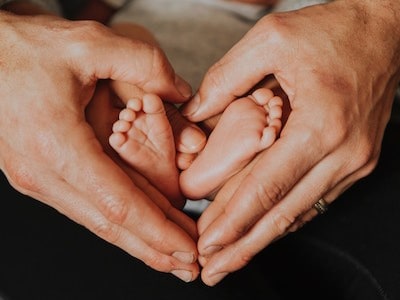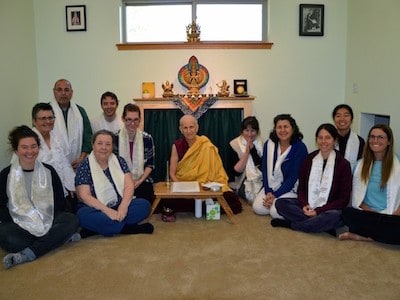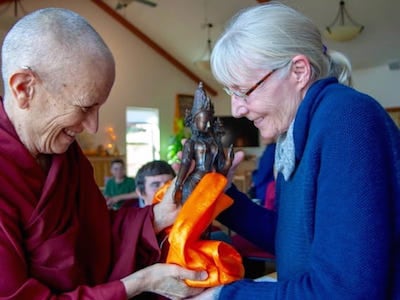The First Precept: Reverence for Life
Commentary on The Five Wonderful Precepts

Although Thich Nhat Hanh’s expanded interpretation and explanation of the five lay precepts differs from that explained by Venerable Chodron, reading and thinking about his explanation can help broaden our understanding and appreciation for what it means to guard our ethical conduct.
Aware of the suffering caused by the destruction of life, I vow to cultivate compassion and learn ways to protect the lives of people, animals, plants and minerals. I am determined not to kill, not to let others kill, and not to condone any act of killing in the world, in my thinking, and in my way of life.
Life is precious. It is everywhere, inside us and all around us; it has so many forms.
The First Precept is born from the awareness that lives everywhere are being destroyed. We see the suffering caused by the destruction of life, and we undertake to cultivate compassion and use it as a source of energy for the protection of people, animals, plants, and minerals. The First Precept is a precept of compassion, karuna—the ability to remove suffering and transform it. When we see suffering, compassion is born in us.
It is important for us to stay in touch with the suffering of the world. We need to nourish that awareness through many means—sounds, images, direct contact, visits, and so on—in order to keep compassion alive in us. But we must be careful not to take in too much. Any remedy must be taken in the proper dosage. We need to stay in touch with suffering only to the extent that we will not forget, so that compassion will flow within us and be a source of energy for our actions. If we use anger at injustice as the source for our energy, we may do something harmful, something that we will later regret. According to Buddhism, compassion is the only source of energy that is useful and safe. With compassion, your energy is born from insight; it is not energy without investigation.
We humans are made entirely of non-human elements, such as plants, minerals, earth, clouds, and sunshine. For our practice to be deep and true, we must include the ecosystem. If the environment is destroyed, humans will be destroyed, too. Protecting human life is not possible without also protecting the lives of animals, plants, and minerals. The Diamond Sutra teaches us that it is impossible to distinguish between sentient and non-sentient beings. This is one of many ancient Buddhist texts that teach deep ecology. Every Buddhist practitioner should be a protector of the environment. Minerals have their own lives, too. In Buddhist monasteries, we chant, “Both sentient and non-sentient beings will realize full enlightenment.” The First Precept is the practice of protecting all lives, including the lives of minerals.
“I am determined not to kill, not to let others kill, and not to condone any act of killing in the world, in my thinking, and in my way of life.”
We cannot support any act of killing; no killing can be justified. But not to kill is not enough. We must also learn ways to prevent others from killing. We cannot say, “I am not responsible. They did it. My hands are clean.” If you were in Germany during the time of the Nazis, you could not say, “They did it. I did not.” If, during the Gulf War, you did not say or do anything to try to stop the killing, you were not practicing this precept. Even if what you said or did failed to stop the war, what is important is that you tried, using your insight and compassion.
It is not just by not killing with your body that you observe the First Precept. If in your thinking you allow the killing to go on, you also break this precept. We must be determined not to condone killing, even in our minds. According to the Buddha, the mind is the base of all actions. It is most dangerous to kill in the mind. When you believe, for example that yours is the only way for humankind and that everyone who follows another way is your enemy, millions of people could be killed because of that idea.
Thinking is at the base of everything. It is important for us to put an eye of awareness into each of our thoughts. Without a correct understanding of a situation or a person, our thoughts can be misleading and create confusion, despair, anger, or hatred. Our most important task is to develop correct insight. If you see deeply into the nature of interbeing, that all things “inter-are,” we will stop blaming, arguing, and killing, and we will become friends with everyone. To practice nonviolence, we must first of all learn ways to deal peacefully with ourselves. If we create true harmony within ourselves, we will know how to deal with family, friends, and associates.
When we protest against a war, for example, we may assume that we are a peaceful person, a representative of peace, but this might not be true. If we look deeply, we will observe that the roots of war are in the unmindful ways we have been living. We have not sown enough seeds of peace and understanding in ourselves and others, therefore we are co-responsible: “Because I have been like this, they are like that.” A more holistic approach is the way of “interbeing:” “This is like this, because that is like that.” This is the way of understanding and love. With this insight, we can see clearly and help our government see clearly. Then we can go to a demonstration and say, “This war is unjust, destructive, and not worthy of our great nation.” This is far more effective than angrily condemning others. Anger always accelerates the damage.
All of us, even pacifists, have pain inside. We feel angry and frustrated, and we need to find someone willing to listen to us who is capable of understanding our suffering. In Buddhist iconography, there is a bodhisattva named Avalokitesvara who has one thousand arms and one thousand hands, and has an eye in the palm of each hand. One thousand hands represent action, and the eye in each hand represents understanding. When you understand a situation or a person, any action you do will help and will not cause more suffering. When you have an eye in your hand, you will know how to practice true nonviolence.
To practice nonviolence, first of all we have to practice it within ourselves. In each of us, there is a certain amount of violence and a certain amount of nonviolence. Depending on our state of being, our response to things will be more or less nonviolent. Even if we take pride in being vegetarian, for example, we have to acknowledge that the water in which we boil our vegetables contains many tiny microorganisms. We cannot be completely nonviolent, but by being vegetarian, we are going in the direction of nonviolence. If we want to head north, we can use the North Star to guides us, but it is impossible to arrive at the North Star. Our effort is only to proceed in that direction.
Anyone can practice some nonviolence, even army generals. They may, for example, conduct their operations in ways that avoid killing innocent people. To help soldiers move in the nonviolent direction, we have to be in touch with them. If we divide reality into two camps—the violent and the nonviolent—and stand in one camp while attacking the other, the world will never have peace. We will always blame and condemn those we feel are responsible for wars and social injustice, without recognizing the degree of violence in ourselves. We must work on ourselves and also work with those we condemn if we want to have a real impact.
It never helps to draw a line and dismiss some people as enemies, even those who act violently. We have to approach them with love in our hearts and do our best to help them move in a direction of nonviolence. If we work for peace out of anger, we will never succeed. Peace is not an end. It can never come about through non-peaceful means.
Most important is to become nonviolence, so that when a situation presents itself, we will not create more suffering. To practice nonviolence, we need gentleness, loving kindness, compassion, joy, and equanimity directed to our bodies, our feelings, and other people. With mindfulness—the practice of peace—we can begin by working to transform the wars in ourselves. There are techniques for doing this. Conscious breathing is one. Every time we feel upset, we can stop what we are doing, refrain from saying anything, and breathe in and out several times, aware of each in-breath and each out-breath. If we are still upset, we can go for walking meditation, mindful of each slow step and each breath we take. By cultivating peace within, we bring about peace in society. It depends on us. To practice peace in ourselves is to minimize the numbers of wars between this and that feeling, or this and that perception, and we can then have real peace with others as well, including the members of our family.
I am often asked, “What if you are practicing nonviolence and someone breaks into your house and tries to kidnap your daughter or kill your husband? What should you do? Should you act in a nonviolent way?” The answer depends on your state of being. If you are prepared, you may react calmly and intelligently, in the most nonviolent way possible. But to be ready to react with intelligence and nonviolence, you have to train yourself in advance. It may take ten years, or longer. If you wait until the time of crisis to ask the question, it will be too late. A this-or-that kind of answer would be superficial. At that crucial moment, even if you know that nonviolence is better than violence, if your understanding is only intellectual and not in your whole beings, you will not act nonviolently. The fear and anger in you will prevent you from acting in the most nonviolent way.
We have to look deeply every day to practice this precept well. Every time we buy or consume something, we may be condoning some form of killing.
While practicing the protection of humans, animals, plants and minerals, we know that we are protecting ourselves. We feel in permanent and loving touch with all species on Earth. We are protected by mindfulness and the loving kindness of the Buddha and many generations of Sanghas who also practice this precept. This energy of loving kindness brings us the feeling of safety, health, and joy, and this becomes real the moment we make the decision to receive and practice the First Precept.
Feeling compassion is not enough. We have to learn to express it. That is why love must go together with understanding. Understanding and insight show us how to act.
Our real enemy is forgetfulness. If we nourish mindfulness every day and water the seeds of peace in ourselves and those around us, we become alive, and we can help ourselves and others realize peace and compassion.
Life is so precious, yet in our daily lives we are usually carried away by our forgetfulness, anger, and worries, lost in the past, unable to touch life in the present moment. When we are truly alive, everything we do or touch is a miracle. To practice mindfulness is to return to life in the present moment. The practice of the First Precept is a celebration of reverence for life. When we appreciate and honor the beauty of life, we will do everything in our power to protect all life.
More on The Five Wonderful Precepts
- The Five Wonderful Precepts: Introduction
- The Second Precept: Generosity
- The Third Precept: Sexual Responsibility
- The Fourth Precept: Deep Listening and Loving Speech
- The Fifth Precept: Diet for a Mindful Society
© 1993 Reprinted from “For a Future to Be Possible” (First Edition) by Thich Nhat Hanh with permission of Parallax Press.
Thich Nhat Hanh
Zen Master Thich Nhat Hanh was a global spiritual leader, poet and peace activist, revered throughout the world for his powerful teachings and bestselling writings on mindfulness and peace. His key teaching is that, through mindfulness, we can learn to live happily in the present moment—the only way to truly develop peace, both in one’s self and in the world. He passed away in January, 2022. Learn more...


